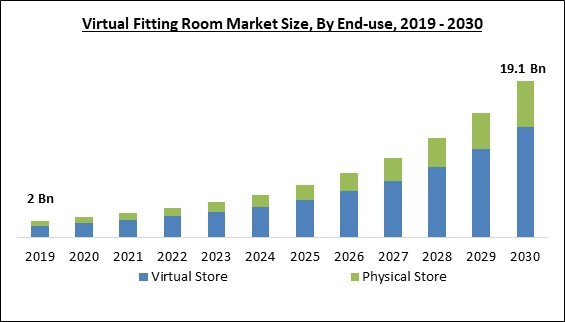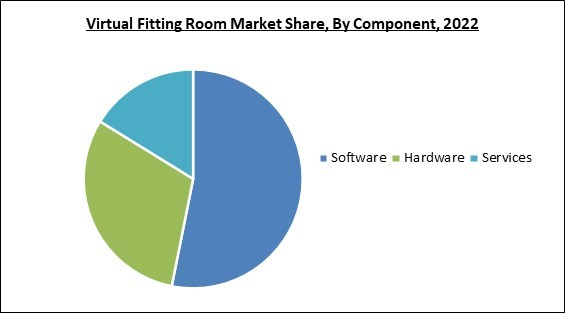The Global Virtual Fitting Room Market size is expected to reach $19.1 billion by 2030, rising at a market growth of 23.6% CAGR during the forecast period.
Virtual Store are gaining traction due to the rising use of smartphones. Hence, Virtual Store would generate approximately 70% share of the market by 2030. Customers that use companies that include augmented reality (AR) in the purchasing process tend to spend more money with such businesses. Magic mirrors, which enable consumers to visualize digitally, are growing in popularity and becoming the new standard on store floors. For example, the estimated amount of U.S. retail e-commerce sales for the first quarter of 2023, adjusted for seasonal fluctuation but not for price adjustments, was $272.6 billion, up 3.0 percent (0.7%) from the fourth quarter of 2022, according to a report released today by the Census Bureau of the Department of Commerce.
The predicted $1,799.5 billion in retail sales for the first quarter of 2023 is an increase of 0.9 percent (0.4%) over the fourth quarter of 2022. The forecast for e-commerce in 2023 increased by 7.8 percent (or around 1.6%) compared to the first quarter of 2022, while total retail sales increased by 3.4 percent (or roughly 0.4%). Some of the factors impacting the market are the growing focus on improving the consumer experience in retail, rising Mobile Commerce Adoption will increase demand for Virtual Fitting Room Tool, and high cost of Virtual Try-On Implementation.
To attract customers, brick-and-mortar retail businesses use various cutting-edge technology. eCommerce and retail have always been highly competitive sectors. Companies are constantly seeking a competitive advantage. This is also expected to fuel the demand for virtual changing rooms. Businesses, particularly fashion stores, are seizing possibilities to reach a broad audience as consumer attention is increasingly focused on mobile devices. Numerous internet shops have created programs that rapidly and interactively show customers their brand's merchandise. As a result, a rising trend toward mobile-commerce adoption is anticipated to fuel market expansion.
However, for more than a decade, virtual reality technology has been widely used by shops. Virtual fitting rooms are being used by retailers, including ASOS, Macy's, and Adidas, both online and in physical locations. Virtual fitting rooms, however, would be a costly investment for smaller businesses. Further, the shop can find it difficult to effortlessly incorporate the technology if they have no prior experience with AI, VR, or AR. These factors are anticipated to limit market expansion.
The market research report covers the analysis of key stake holders of the market. Key companies profiled in the report include Zugara Inc., Sizebay (Bossanova Investimentos), Magic Mirror, Zalando SE (Fision AG), MemoMi Labs Inc. (Walmart Inc.), SenseMI Smart Solutions (Viubox), Else Corp Srl, FXGear Inc., Metail Limited (TAL Apparel), and Snap, Inc. (Fit Analytics).
Virtual Store are gaining traction due to the rising use of smartphones. Hence, Virtual Store would generate approximately 70% share of the market by 2030. Customers that use companies that include augmented reality (AR) in the purchasing process tend to spend more money with such businesses. Magic mirrors, which enable consumers to visualize digitally, are growing in popularity and becoming the new standard on store floors. For example, the estimated amount of U.S. retail e-commerce sales for the first quarter of 2023, adjusted for seasonal fluctuation but not for price adjustments, was $272.6 billion, up 3.0 percent (0.7%) from the fourth quarter of 2022, according to a report released today by the Census Bureau of the Department of Commerce.
The predicted $1,799.5 billion in retail sales for the first quarter of 2023 is an increase of 0.9 percent (0.4%) over the fourth quarter of 2022. The forecast for e-commerce in 2023 increased by 7.8 percent (or around 1.6%) compared to the first quarter of 2022, while total retail sales increased by 3.4 percent (or roughly 0.4%). Some of the factors impacting the market are the growing focus on improving the consumer experience in retail, rising Mobile Commerce Adoption will increase demand for Virtual Fitting Room Tool, and high cost of Virtual Try-On Implementation.
To attract customers, brick-and-mortar retail businesses use various cutting-edge technology. eCommerce and retail have always been highly competitive sectors. Companies are constantly seeking a competitive advantage. This is also expected to fuel the demand for virtual changing rooms. Businesses, particularly fashion stores, are seizing possibilities to reach a broad audience as consumer attention is increasingly focused on mobile devices. Numerous internet shops have created programs that rapidly and interactively show customers their brand's merchandise. As a result, a rising trend toward mobile-commerce adoption is anticipated to fuel market expansion.
However, for more than a decade, virtual reality technology has been widely used by shops. Virtual fitting rooms are being used by retailers, including ASOS, Macy's, and Adidas, both online and in physical locations. Virtual fitting rooms, however, would be a costly investment for smaller businesses. Further, the shop can find it difficult to effortlessly incorporate the technology if they have no prior experience with AI, VR, or AR. These factors are anticipated to limit market expansion.
Component Outlook
Based on component, the market is segmented into hardware, software, and services. In 2022, the hardware segment acquired a substantial revenue share in the market. High-resolution cameras, a digital screen, the creation of 3D and 2D fashion models, and customization are required for the in-store experience. The hardware component's excellent efficiency improves customers' virtual experiences. As a result, traditional retail outlets and internet retailers use cutting-edge technologies to provide more accurate product fitting.Software Type Outlook
Under software type, the market is divided into cloud and on-premise. In 2022, the cloud segment generated the maximum revenue share in the market. Retailers who use innovative cloud-based solutions can better address problems and create enduring resilience for business development and innovation. Cloud usage has also increased due to consumer desire for retailers to deliver a futuristic experience when shopping while bringing about convenient digital transformation in the retail sector. As a result of this, cloud-based deployment is rising, thereby leading to market growth.Application Outlook
By application, the market is divided into apparel, beauty & cosmetics, eyewear, footwear, and others. In 2022, the apparel segment registered the largest revenue share in the market. The increasing use of AR and VR to provide an immersive experience is anticipated to open up new development prospects for the garment sector. Apparel sales are among the most-grossing categories for online and in-person purchases, and they also have the greatest rates of returns and exchanges. Online clothing stores are using fitting room solutions with artificial intelligence to propose the customer sizes, designs, and styles based on their previous searches and purchases to decrease the number of return/exchange instances and improve the shopping experience for consumers.End-Use Outlook
On the basis of end-use, the market is divided into physical and virtual stores. In 2022, the virtual store segment dominated the market with the maximum revenue share. Users are drawn to the convenience of e-commerce websites because they provide simple purchasing, extensive product portfolios, and quick product comparisons. The end-users are successfully supported in making better purchase selections using virtual fitting room technology, which has emerged as one of the vital revenue-generating platforms for online shops. Additionally, meeting consumers' specific demands and enhancing their buying experiences are the simplest ways to draw them to online purchases.Regional Outlook
Region wise, the market is analysed across North America, Europe, Asia Pacific and LAMEA. In 2022, Europe region registered the largest revenue share in the market. Numerous renowned fashion companies are present in the area, which is responsible for this rapid expansion. Additionally, the rising competitiveness among retailers as they increasingly adopt innovative digital technologies to increase foot traffic and engagement levels and the growing demand for better solutions relating to the customer buying experience is anticipated to propel the regional market even further.The market research report covers the analysis of key stake holders of the market. Key companies profiled in the report include Zugara Inc., Sizebay (Bossanova Investimentos), Magic Mirror, Zalando SE (Fision AG), MemoMi Labs Inc. (Walmart Inc.), SenseMI Smart Solutions (Viubox), Else Corp Srl, FXGear Inc., Metail Limited (TAL Apparel), and Snap, Inc. (Fit Analytics).
Scope of the Study
By End-use
- Virtual Store
- Physical Store
By Component
- Software
- Cloud
- On-premise
- Hardware
- Services
By Application
- Apparel
- Eyewear
- Footwear
- Beauty & Cosmetic
- Others
By Geography
- North America
- US
- Canada
- Mexico
- Rest of North America
- Europe
- Germany
- UK
- France
- Russia
- Spain
- Italy
- Rest of Europe
- Asia Pacific
- China
- Japan
- India
- South Korea
- Singapore
- Malaysia
- Rest of Asia Pacific
- LAMEA
- Brazil
- Argentina
- UAE
- Saudi Arabia
- South Africa
- Nigeria
- Rest of LAMEA
Key Market Players
List of Companies Profiled in the Report:
- Zugara Inc.
- Sizebay (Bossanova Investimentos)
- Magic Mirror
- Zalando SE (Fision AG)
- MemoMi Labs Inc. (Walmart Inc.)
- SenseMI Smart Solutions (Viubox)
- Else Corp Srl
- FXGear Inc.
- Metail Limited (TAL Apparel)
- Snap, Inc. (Fit Analytics)
Unique Offerings
- Exhaustive coverage
- The highest number of Market tables and figures
- Subscription-based model available
- Guaranteed best price
- Assured post sales research support with 10% customization free
Table of Contents
Chapter 1. Market Scope & Methodology
Chapter 2. Market Overview
Chapter 3. Global Virtual Fitting Room Market by End-use
Chapter 4. Global Virtual Fitting Room Market by Component
Chapter 5. Global Virtual Fitting Room Market by Application
Chapter 6. Global Virtual Fitting Room Market by Region
Chapter 7. Company Profiles
Companies Mentioned
- Zugara Inc.
- Sizebay (Bossanova Investimentos)
- Magic Mirror
- Zalando SE (Fision AG)
- MemoMi Labs Inc. (Walmart Inc.)
- SenseMI Smart Solutions (Viubox)
- Else Corp Srl
- FXGear Inc.
- Metail Limited (TAL Apparel)
- Snap, Inc. (Fit Analytics)
Methodology

LOADING...










